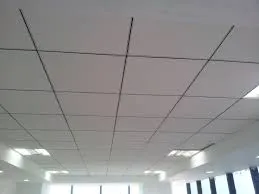Nov . 13, 2024 19:55 Back to list
drop ceiling grid materials
Understanding Drop Ceiling Grid Materials A Comprehensive Overview
Drop ceilings, also known as suspended ceilings, are a popular choice in both residential and commercial environments. They not only provide a practical solution for concealing ductwork, plumbing, and electrical systems but also enhance a space's aesthetic appeal. One of the critical components of a drop ceiling is the grid system, which supports the ceiling tiles. In this article, we will explore various materials used in drop ceiling grid systems, focusing on their qualities and applications.
Understanding Drop Ceiling Grid Materials A Comprehensive Overview
Another option for drop ceiling grids is wood. Wooden grids provide a warm and natural aesthetic, making them an ideal choice for residential spaces or commercial environments that aim for a cozy atmosphere. However, wood can be susceptible to moisture and warping, so it is essential to treat it properly and avoid using it in high-humidity areas.
drop ceiling grid materials

In recent years, plastic grids have gained popularity due to their lightweight characteristics and resistance to corrosion and moisture. These grids can come pre-finished, offering versatility in design choices. Plastic systems are particularly advantageous in environments where metal may rust, such as pools or spas. However, they may not support as much weight as metal grids, so it’s important to consider the type of ceiling tiles being used.
Fabric grids are another innovative solution emerging in the market. These grids can create a softer look and feel, ideal for office spaces or creative environments. The fabric is often suspended from a lightweight framework, allowing for easy installation and modification. Additionally, fabric grids can improve sound absorption, leading to a quieter atmosphere—an essential feature in busy office settings.
In conclusion, selecting the right materials for drop ceiling grid systems is crucial for achieving both functionality and aesthetic appeal. Metal, wood, plastic, and fabric all offer distinct advantages and considerations. When designing a space, it is essential to weigh these factors carefully to ensure that the chosen grid system meets the practical needs while aligning with the overall design vision. Whether for a home or a commercial setting, the right choice can enhance the ambiance and performance of the environment significantly.
-
Durable Ceiling T Grid Systems | Easy InstallationNewsAug.29,2025
-
PVC Gypsum Ceiling: Durable, Laminated Tiles for Modern SpacesNewsAug.28,2025
-
Pvc Gypsum Ceiling Is DurableNewsAug.21,2025
-
Mineral Fiber Board Is DurableNewsAug.21,2025
-
Ceiling Tile Clip Reusable DesignNewsAug.21,2025
-
Ceiling T Grid Modular DesignNewsAug.21,2025







